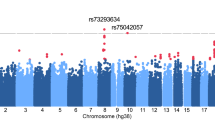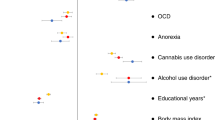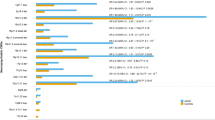Abstract
Several lines of evidence have suggested that ADHD is a polygenic disorder produced by the interaction of several genes each of a minor effect. Synaptosomal-associated protein 25 (SNAP-25) is a presynaptic plasma membrane protein which is expressed highly and specifically in the nerve cells. The gene encodes a protein essential for synaptic vesicle fusion and neurotransmitter release. Animal model studies showed that the coloboma mouse mutant has a hyperactive phenotype similar to that of ADHD. The hyperactive phenotype of this model has been shown to be the result of a deletion of the SNAP-25 gene. DNA variations within or closely mapped to the SNAP-25 gene may alter the level of expression and hence may have an effect on the function of synaptic vesicle fusion and neurotransmitter release. Using HHRR and TDT we analysed 93 ADHD nuclear families from Ireland and found increased preferential transmission of SNAP-25/DdeI allelel to ADHD cases; HHRR (χ2 = 6.55, P = 0.01) and linkage (TDT) (χ2 = 6.5, P = 0.015). In contrast to our findings, Barr et al1 reported an increased transmission of allele 2 of the DdeI polymorphism though this was not statistically significant. However, they also reported a significantly increased transmission of a haplotype (made of allele 1 of MnlI and allele 2 of the DdeI) in their Canadian ADHD sample. It is not clear what the role of SNAP-25 in ADHD is until these findings are either confirmed or refuted in other ADHD samples.
This is a preview of subscription content, access via your institution
Access options
Subscribe to this journal
Receive 12 print issues and online access
$259.00 per year
only $21.58 per issue
Buy this article
- Purchase on Springer Link
- Instant access to full article PDF
Prices may be subject to local taxes which are calculated during checkout
Similar content being viewed by others
References
Barr CL, Feng Y, Wigg K, Bloom S, Roberts W, Malone M et al. Identification of DNA variants in the SNAP-25 gene and linkage study of these polymorphisms and attention-deficit hyperactivity disorder Mol Psychiatry 2000; 5: 405–409
Barkley RA . Attention-deficit hyperactivity disorder Scientific American 1998; 279: 66–71
Tannock R . Attention deficit hyperactivity disorder: advances in cognitive, neurobiological and genetic research J Child Psychol Psychiatry 1998; 39: 65–99
Zametkin AJ, Nordahl TE, Gross J, King AC, Semple WE, Rumsey J et al. Cerebral glucose metabolism in adults with hyperactivity of childhood onset New Eng J Med 1990; 323: 1361–1366
Biederman J, Faraone SV, Keenan K, Benjamin J, Krifcher B, Moore C et al. Further evidence for family-genetic risk factors in attention-deficit hyperactivity disorder: patterns of comorbidity in probands and relatives in psychiatrically and pediatrically referred samples Arch Gen Psychiatry 1992; 49: 728–738
Gillis JJ, Gilger JW, Pennington BF, DeFries JC . Attention deficit disorder in reading-disabled twins: evidence for a genetic aetiology J Abnorm Child Psychol 1992; 20: 303–315
Sherman DK, Iacona WG, McGue M . Attention-deficit hyperactivity disorder dimensions: a twin study of attention and impulsivity-hyperactivity J Am Acad Child Adolesc Psychiatry 1997; 36: 745–753
Levy F, Hay DA, McStephen M, Wood C, Waldman I . Attention-deficit hyperactivity disorder: a category or a continuum? Genetic analysis of a large-scale twin study J Am Acad Child Adolesc Psychiatry 1997; 36: 737–744
Sprich S, Biederman J, Crawford MH, Mundy E, Faraone SV . Adoptive and biological families of children and adolescents with ADHD J Am Acad Child Adolesc Psychiatry 2000; 39: 1432–1437
Greenhill LL . Pharmacologic treatment of attention deficient hyperactivity disorder Psychiatr Clin North Am 1992; 15: 1–27
Giros B, Jaber M, Jones S, Wightman RM, Caron MG . Hyperlocomotion and indifference to cocaine and amphetamine in mice lacking the dopamine transporter Nature 1996; 379: 606–612
Cook EH, Stein MA, Krasowski MD, Cox NJ, Olkon DM, Kieffer JE, Leventhal BL . Association of attention deficit disorder and the dopamine transporter gene Am J Hum Genet 1995; 56: 993–998
LaHoste GJ, Swanson JM, Wigal SB, Glabe C, Wigal T, King N, Kennedy JL . Dopamine D4 receptor gene polymorphism is associated with attention deficit hyperactivity disorder Mol Psychiatry 1996; 1: 121–124
Daly G, Hawi Z, Fitzgerald M, Gill M . Mapping susceptibility loci in attention deficit hyperactivity disorder: preferential transmission of parental alleles at DAT1, DBH and DRD5 to affected children Mol Psychiatry 1999; 4: 192–196
Castellanos FX, Lewczyk CM, Fernandez T, Koprivica V, Kashani A, Tayebi N et al. Lack of an association between dopamine transporter (DAT1) and ADHD Mol Psychiatry 1999; 4: S80
Hawi Z, McCarron M, Kirley K, Fitzgerald M, Gill M . No association of the dopamine DRD4 receptor (DRD4) gene polymorphism with attention deficit hyperactivity disorder (ADHD) in the Irish population Am J Med Genet (Neuropsych Genet) 2000; 96: 268–272
Sollner T, Whiteheart SW, Brunner M, Erdjument-Bromage H, Geromanos S, Tempst P, Rothman JE . SNAP receptors implicated in vesicle targeting and fusion Nature 1993; 362: 318–324
Hess EJ, Collins KA, Wilson MC . Mouse model for hyperkinesis implicates SNAP in behavioural regulation J Neurosci 1996; 16: 3104–3111
Maglott DR, Feldblyum TV, Durkin AS, Nierman WC . Radiation hybrids mapping of SNAP, PCSK2 and THBD (human chromosome 20p) Mamm Genome 1996; 7: 400–401
Wilson MC . Coloboma mouse mutant as an animal model of hyperkenesis and attention deficit hyperactivity disorder Neurosci Biobehav Rev 2000; 24: 51–57
Raber J, Mehta PP, Kreifeldt M, Parsons LH, Weiss F, Bloom FE, Wilson MC . Coloboma hyperactive mutant mice exhibit regional and transmitter-specific deficits in neurotransmission J Neurochem 1997; 68: 176–186
Barkley RA . Attention-deficit/hyperactivity disorder, self-regulation, and time: toward a more comprehensive theory Dev Behav Pediatrics 1997; 18: 271–279
Kirley A, Hawi Z, Daly G, McCarron M, Mullins C, Millar N, Fitzgerald M, Gill M . Dopaminergic system genes in ADHD: towards a biological hypothesis Neuropsychopharmacology (in press)
Hayward BE, Kamiya M, Strain L, Moran V, Campbell R, Hayashizaki Y, Bonthron DT . The human GNAS1 gene is imprinted and encodes distinct paternally and biallelically expressed G proteins Proc Natl Acad Sci USA 1998; 95: 10038–10043
Hess EJ, Rogan PK, Domoto M, Tinker DE, Ladda RL, Ramer JC . Absence of linkage of apparently single gene mediated ADHD with the human syntenic region of the mouse mutant Coloboma Am J Med Genet 1995; 60: 573–579
Ward MF, Wender PH, Reimherr FW . The Wender Utah Rating Scale: an aid in the retrospective diagnosis of childhood attention deficit hyperactivity disorder Am J Psychiatry 1993; 150: 885–890
Terwilliger JD, Ott J . ‘A haplotype based haplotype relative risk’ approach to detecting allelic association Hum Hered 1992; 42: 337–346
Spielman RS, McGinnis RE, Ewens WJ . Transmission test for linkage disequilibrium: the insulin gene region and insulin-dependent diabetes mellitus (IDDM) Am J Hum Genet 1993; 52: 506–516
Terwilliger J, Ott J . Handbook for Human Genetic Linkage Johns Hopkins University Press: Baltimore 1994
Acknowledgements
We would like to acknowledge the generous support of the Health Research Board, Dublin, The Wellcome Trust (ZH and AK), and the Hyperactive and Attention Disorder (HAD) Group Ireland. We would also like to thank the families who participated in the study.
Author information
Authors and Affiliations
Corresponding author
Rights and permissions
About this article
Cite this article
Brophy, K., Hawi, Z., Kirley, A. et al. Synaptosomal-associated protein 25 (SNAP-25) and attention deficit hyperactivity disorder (ADHD): evidence of linkage and association in the Irish population. Mol Psychiatry 7, 913–917 (2002). https://doi.org/10.1038/sj.mp.4001092
Received:
Revised:
Accepted:
Published:
Issue Date:
DOI: https://doi.org/10.1038/sj.mp.4001092
Keywords
This article is cited by
-
Systems biology reveals reprogramming of the S-nitroso-proteome in the cortical and striatal regions of mice during aging process
Scientific Reports (2020)
-
The Association of SNAP25 Gene Polymorphisms in Attention Deficit/Hyperactivity Disorder: a Systematic Review and Meta-Analysis
Molecular Neurobiology (2017)
-
Expanding the toolbox of ADHD genetics. How can we make sense of parent of origin effects in ADHD and related behavioral phenotypes?
Behavioral and Brain Functions (2015)
-
Genetic Influences on Response to Novel Objects and Dimensions of Personality in Papio Baboons
Behavior Genetics (2015)
-
Synaptosomal-associated protein 25 mutation induces immaturity of the dentate granule cells of adult mice
Molecular Brain (2013)



